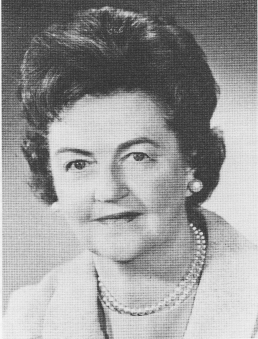Nationality American Name Bernice Eddy | Died January 1, 1999 | |
 | ||
Born Bernice E. EddySeptember 30, 1903New York, New York ( 1903-09-30 ) | ||
Bernice Eddy (1903–1989) was an American virologist and epidemiologist. She and Sarah Elizabeth Stewart are known for their discoveries related to polyomavirus and SV40 in particular, a cancer-causing monkey virus that millions of people were exposed to through contaminated polio vaccines.
Contents
Personal life
Eddy was born to Dr. Nathan E. Eddy and Clara C. Eddy (née Griffith) in Glendale, West Virginia. She was the oldest of four children.
She earned a degree in bacteriology from Marietta College in 1924 and a Ph.D. from the University of Cincinnati in 1927.
She married Dr. Jerald Wooley.
Polyomavirus
Building on earlier work by Ludwig Gross, Sarah Elizabeth Stewart and Bernice E. Eddy were the first to describe the polyomavirus. They satisfied Koch's postulates to demonstrate that polyomavirus can cause cancer to be transmitted from animal to animal. The virus was named the Stewart-Eddy or SE polyoma virus, after their respective surnames.
Cutter incident
In 1954, while the NIH was testing the first commercial polio vaccines, Eddy's job was to test the vaccines from five different companies. Testing the vaccines on 18 monkeys, she and her team discovered that the inactivated vaccine manufactured by Cutter Laboratories contained residual live poliovirus, resulting in the monkeys showing polio-like symptoms and paralysis. Eddy reported her findings to William Workman, head of the Laboratory of Biologics Control, but her findings were never given to the vaccine licensing advisory committee. Although then-NIH director William Sebrell was notified, he chose to ignore Eddy's findings and proceeded to license the Cutter vaccine along with the others. Dr. James Shannon, the associate director of the NIH, managed to get the vaccines recalled.
SV40 virus
In 1961, Eddy showed that an extract of rhesus monkey kidney cells (RMKC), notable because of its use as a growth medium in the creation of the polio vaccine, caused tumors in newborn hamsters. In 1962 she presented evidence that the oncological agent present in the RMKC serum was capable of inducing histologically similar tumors under the same conditions as SV40, and that these tumors showed different properties than the SE polyoma virus, which was the only other biological material known to be capable of inducing tumors in almost all hamsters injected as newborns. Similar to SV40, RMKC extracts remained infectious after passage through filters, and similar levels of exposure to diethyl ether, heat, and storage at -70 °C. Eddy also provided evidence that the RMKC extracts were inhibited (tumors would not develop) under conditions that also inhibited SV40 tumor development. This includes inhibition in animals that received RMKC extracts combined with anti-SV40 rabbit serum. Given the preponderance of evidence, this paper drew the conclusion that the oncological agent in the RMKC extracts were identical to the SV40 virus.
This discovery was of both practical and theoretical importance. Practically speaking, the discovery explained the origins of the widespread contamination of a variety of stocks of seed viruses and live polio virus vaccine by SV40 that had been written about in a 1960 paper written by Ben Sweet and Maurice Hilleman. Eddy suggested that this contamination could be avoided in the future by screening cultures of C. aethiops kidney cells for the characteristic cytopathic (cellular) changes that SV40 causes. This discovery led to Merck to voluntarily withdraw its killed-virus polio vaccine. Theoretically speaking, it added to a growing body of evidence that the monkey, like the mouse, could harbor oncogenic (cancer causing) viruses that could affect other animal species.
In 1998, the National Cancer Institute undertook a large study, using cancer case information from the Institute's SEER database. The published findings from the study were considered of little value in a 2002 review that called for further investigation. Another large study in Sweden examined cancer rates of 700,000 individuals who had received potentially contaminated polio vaccine as late as 1957; the study again revealed no increased cancer incidence between persons who received polio vaccines containing SV40 and those who did not. The question of whether SV40 causes cancer in humans remains controversial, however, and the development of improved assays for detection of SV40 in human tissues will be needed to resolve the controversy.
